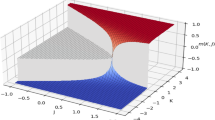Abstract
For a family of translation-invariant, ferromagnetic, one-component spin systems—which includes Ising and ϕ4 models—we prove that (i) the phase transition is sharp in the sense that at zero magnetic field the high- and low-temperature phases extend up to a common critical point, and (ii) the critical exponent β obeys the mean field bound β⩽1/2. The present derivation of these nonperturbative statements is not restricted to “regular” systems, and is based on a new differential inequality whose Ising model version isM⩽βhχ+M 3+ βM 2∂M/∂β. The significance of the inequality was recognized in a recent work on related problems for percolation models, while the inequality itself is related to previous results, by a number of authors, on ferromagnetic and percolation models.
Similar content being viewed by others
References
M. Aizenman, Rigorous studies of critical behavior. II, inStatistical Physics and Dynamical Systems: Rigorous Results, J. Fritz, A. Jaffe, and D. Szász, eds. (Birkhäuser, Boston, 1985); Absence of an intermediate phase for a general class of one-component ferromagnetic models,Phys. Rev. Lett. 54: 839–842 (1985).
M. Aizenman and D. J. Barsky, Sharpness of the phase transition in percolation models,Commun. Math. Phys. 108:489–526 (1987).
M. Aizenman and R. Graham, On the renormalized coupling constant and the susceptibility in ϕ 44 field theory and the Ising model in four dimensions,Nucl. Phys. B 225[FS9]:261–288 (1983).
J. Fröhlich and A. D. Sokal, The random walk representation of classical spin systems and correlation inequalities. III. Nonzero magnetic field, in preparation.
J. T. Chayes and L. Chayes, An inequality for the infinite cluster density in Bernoulli percolation,Phys. Rev. Lett. 56:1619–1622 (1986).
R. B. Griffiths, Rigorous results for Ising ferromagnets of arbitrary spin,J. Math. Phys. 10:1559–1565 (1969).
B. Simon and R. B. Griffiths, The (ϕ4)2 field theory as a classical Ising model,Commun. Math. Phys. 33:145–164 (1973).
T. D. Lee and C. N. Yang, Statistical theory of equations of state and phase transitions, II, Lattice gas and Ising model,Phys. Rev. 87:410–419 (1952).
R. Peierls, On Ising's model of ferromagnetism,Proc. Camb. Phil. Soc. 32:477–481 (1936); see also R. B. Griffiths, Peierls proof of spontaneous magnetization in a two-dimensional Ising ferromagnet,Phys. Rev. 136A:437–439 (1964); R. L. Dobrushin, The existence of a phase transition in the two- and three-dimensional Ising models,Teorija Verojatn. Prim. 10:209–230 (1965).
P. J. Thouless, Long range order in one-dimensional Ising systems,Phys. Rev. 187:732–733 (1969); see also F. Dyson, Existence of a phase transition in a one-dimensional Ising ferromagnet,Commun. Math. Phys. 12:91–107 (1969); P. W. Anderson, G. Yuvall, and D. R. Hamaan, Exact results in the Kondo problem. II. Scaling theory, qualitatively correct solution and some new results on one-dimensional classical statistical models,Phys. Rev. B 1:4464–4473 (1970).
J. Fröhlich and T. Spencer, The phase transition in the one-dimensional Ising model with the 1/r 2 interaction energy,Commun. Math. Phys. 84:87–101 (1982); see also M. Aizenman, J. T. Chayes, L. Chayes, and C. M. Newman: Discontinuity of the order parameter in one dimensional 1/¦x−y¦2 Ising and Potts models, to be submitted for publication.
J. M. Kosterlitz and D. J. Thouless, Ordering, metastability and phase transitions in two-dimensional systems,J. Phys.C 6:1181–1203 (1973); see also S. Elitzur, R. Pearson, and J. Shigemitsu, Phase structure of discrete Abelian spin and gauge systems,Phys. Rev. D 19:3698–3714 (1979).
J. Fröhlich and T. Spencer, The Kosterlitz-Thouless transition in two-dimensional Abelian spin systems and the Coulomb gas,Commun. Math. Phys. 81:527–602 (1981).
B. Simon, Correlation inequalities and the decay of correlations in ferromagnets,Commun. Math. Phys. 77:111–126 (1980).
J. L. Lebowitz, Coexistence of phases in Ising ferromagnets,J. Stat. Phys. 16:463–476 (1977).
M. Aizenman and R. Fernández, On the critical behavior of the magnetization in highdimensional Ising models,J. Stat. Phys. 44:393–454 (1986).
K. G. Wilson and M. E. Fisher, Critical exponents in 3.99 dimensions,Phys. Rev. Lett. 28:240–243 (1970).
A. B. Harris, T. C. Lubensky, W. K. Holcomb, and C. Dasgupta, Renormalization group approach to percolation problems,Phys. Rev. Lett. 35:327–330 (1975).
M. Aizenman, Geometric analysis of ϕ 24 fields and Ising models. Parts I and II,Commun. Math. Phys. 86:1–48 (1982).
M. Aizenman and C. M. Newman, Tree graph inequalities and critical behavior in percolation models,J. Stat. Phys. 36:107–143 (1984).
R. B. Griffiths, C. A. Hurst, and S. Sherman, Concavity of the magnetization of an Ising ferromagnet in a positive external field,J. Math. Phys. 11:790–795 (1970).
M. Aizenman, Rigorous studies of critical behavior, inApplications of Field Theory in Statistical Mechanics, L. Garrido, ed. (Springer-Verlag, Lecture Notes in Physics, 1985).
R. B. Griffiths, Correlations in Ising ferromagnets. II. External magnetic fields,J. Math. Phys. 8:484–489 (1967).
D. C. Brydges, J. Fröhlich, and T. Spencer, The random walk representation of classical spin systems and correlation inequalities,Commun. Math. Phys. 83:123–150 (1982); see also J. Fröhlich, On the triviality of λφ 4d theories and the approach to the critical point ind − > 4 dimensions,Nucl. Phys. B 200[FS4]:281–296 (1982); D. Brydges, J. Fröhlich, and A. D. Sokal, The random walk representation of classical spin systems and correlation inequalities. II. The skeleton inequalities,Commun. Math. Phys. 91:117–139 (1983).
Author information
Authors and Affiliations
Rights and permissions
About this article
Cite this article
Aizenman, M., Barsky, D.J. & Fernández, R. The phase transition in a general class of Ising-type models is sharp. J Stat Phys 47, 343–374 (1987). https://doi.org/10.1007/BF01007515
Received:
Issue Date:
DOI: https://doi.org/10.1007/BF01007515



